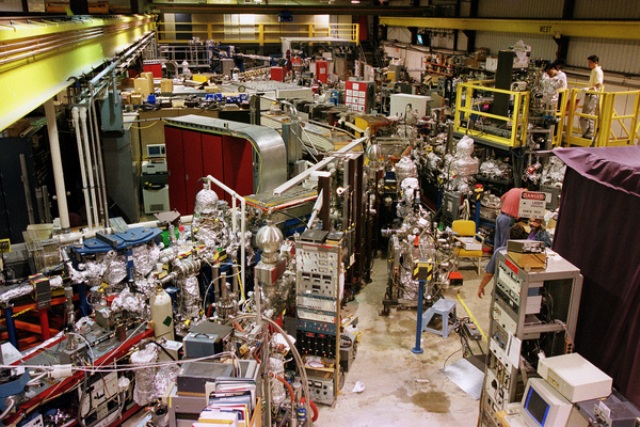Feb 17 2014
Faced with a federal funding shortfall, the University of Wisconsin-Madison has decided to shut down its Synchrotron Radiation Center near Stoughton on March 7.
 Numerous stations of research lab equipment are attached to the particle beam ring at the Synchrotron Radiation Center near Stoughton in this 2000 image. The facility is built around a synchrotron, a loop the size of a baseball diamond carrying speeding electrons that emit streams of photons.
Numerous stations of research lab equipment are attached to the particle beam ring at the Synchrotron Radiation Center near Stoughton in this 2000 image. The facility is built around a synchrotron, a loop the size of a baseball diamond carrying speeding electrons that emit streams of photons.
The facility is built around a synchrotron, a loop the size of a baseball diamond carrying speeding electrons that emit streams of energetic light particles, or photons, at every bend in the loop. These streams of infrared, ultraviolet or soft X-ray light are directed along various "beamlines" to targets housing scientific experiments related to the composition and structure of the target material.
The core of the synchrotron, called Aladdin, is a storage ring that holds speeding electrons that can be tapped for a multitude of experiments. Since Aladdin opened in 1986, it's been used by scientists from around the world, and has accounted for many significant achievements in a broad range of sciences, says synchrotron director Joseph Bisognano, a professor of engineering physics at UW-Madison.
Magnetism: Studies performed about 20 years ago supported a deeper understanding of magnetism in materials, contributing to a million-fold increase in the storage density of computer hard disks.
High-temperature superconductivity: Researchers have greatly expanded the understanding of materials that conduct electricity with no resistance at temperatures that can be reached with liquid-nitrogen cooling, which is far cheaper than the liquid helium needed by common superconductors. These materials could be used in scientific instruments, magnetic levitation trains and electric power transmission.
Deciphering electrons: Methods have been developed to examine the basic quantum mechanical behavior of electrons that controls the properties and functionality of matter.
Exotic materials: Explorations of materials composed of ultra-thin layers could bear fruit in silicon-free, next-generation computer chips or flexible display screens.
Biology: Photons from Aladdin have been used to study algae, fungi, cartilage, scar tissue and changes in the brain associated with Alzheimer's disease.
"The science conducted at the synchrotron is outstanding," says associate dean for physical sciences Steven Ackerman. "The center has consistently received high reviews from external expert panels, which acknowledge its value as a national resource. We see more evidence of its importance in the visits from hundreds of researchers from the United States and around the world who have come to rely on this instrument."
Even though Aladdin was commissioned 28 years ago, "We are always building new ways to use photons from the beam," says Bisognano. "In the past month, we have had scientists coming from China. They have their own sophisticated light source, but they come here because we've continually upgraded this instrument."
One recent innovation concerns a source of electrons planned for a next-generation facility: a free electron laser. Many lasers that supply beams of photons are built with gases like neon or argon, but the free electron laser "is the latest rage, the ultimate light source," says Bisognano.
"Our superconducting electron source is the critical technology to make these high-power devices a reality. People have been trying do this for a decade. We got this source going last summer, and it's the most successful one to date, but now we are out of federal money and the people are leaving."
Some personnel have found jobs at other national labs, at UW-Madison and in industry, and others are retiring. Bisognano is moving to campus to teach engineering physics, yet a number of highly specialized scientists are looking for work.
Using a beamline that opened in 2009, Carol Hirschmugl, a professor of physics at the University of Wisconsin-Milwaukee, is taking advanced infrared images of everything from volcanic material to neurons, breast cancer cells, cicada wings and a promising new carbon structure called graphene.
"It's unique," she says. "There is nothing like this in the world to get 3-D images, which are critical for biological systems, where so much changes with depth." Hirschmugl and her colleagues have already detected fat molecules in stem cell colonies, which may affect how these universal cells specialize into neurons, blood cells or muscle.
The advanced design of the infrared beamline fills a special infrared detector that gathers in one minute as much data as other systems acquire in three days, Hirschmugl says, and with the synchrotron about to close, she has begun discussions with another university about a beamline that is about to be started.
"It will take years to get back to where we are today, and that beamline may come within a factor of two, but I don't yet know if it will be able to replicate what we have in Stoughton," she says.
And that, admittedly, is frustrating to staff at the synchrotron. Bisognano, for example, insists that the cutting-edge science and instrument developments such as the infrared beamline and the electron source prove that the synchrotron facility is still essential to scientific advancement.
"Over the past few years, we've developed an infrared beam that can measure the structure and the chemical identity of the target material at the same time," Bisognano says. "This device is the best in the world, and that's probably the saddest part about shutting this down."